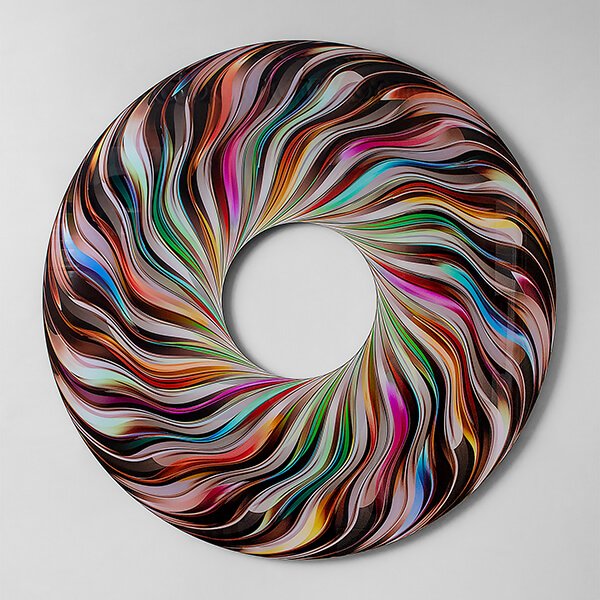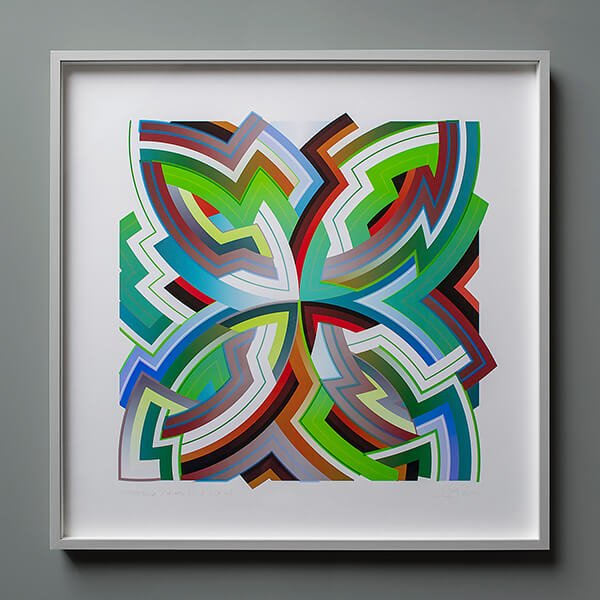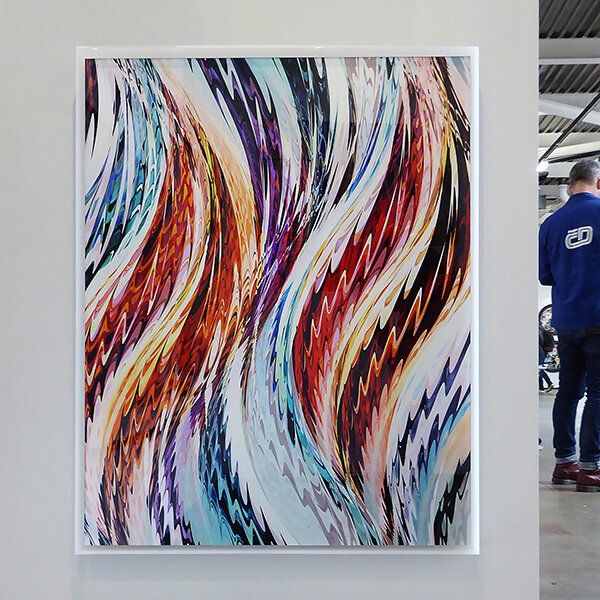Members of my Print Club receive three or four exclusive new editions in the post each year. Sign up today to receive the latest work…
About Balla / linear progression
Balla / linear progression / EPC is the 30th work for my Experimental Print Club. I editioned the piece in April 2025 at my studio in Bristol. The edition consists of five variations, so I asked club members to choose which variant they would prefer to have in their collection. As a result, each variant was only printed at most three times and a couple of the images are unique.
.
Balla / linear progression / EPC #30
.
10 colour pigment print on Hahnemühle 305gsm ultra smooth photo rag
Edition of 12, plus 5 APs
Printed in April 2025
.
Sheet size 56cm H x 56cm W
Image size 44cm H x 44cm W
In situ and in the studio
About the Print Club
If you’d like to receive three or four exclusive new editions in the post each year, alongside personal news and views from the studio, and invitations to shows and fairs, please do consider becoming a member of my Experimental Print Club. You can join or leave the club at any time, with absolutely no obligation to stay any longer than you want to.
New works are sent out somewhat sporadically throughout the year, often in line with the changing seasons. Each piece is unique, exclusive, and only available on the day it’s editioned, the size of the edition being determined by the number of members on the day.
I hope the club presents a more personal and intriguing way to connect with the studio, by creating a platform for collecting engaging new works for your home. The club is hosted online here, and I send out fairly regular blog posts and emails about the work too. I’d like to think that it’s an interesting proposition!
Membership is currently priced at £36 per month inc. UK delivery, or £42 for an international address.
From my blog / 10th April 2025
I'm looking forward to printing the drawings as new works on paper, probably at around 60cm square, with maybe a 7cm white border all around. I'll need to make a few proofs to ensure the size works well on the wall. Until then, I hope these first studies using this new technique may be of interest, I'm already looking forward to drawing the next series this way...
I thought it might be interesting to see some of the in progress images here too. These are typical of the kind of modular components I’m working with, and maybe give some idea of how the drawings are constructed. I imagine it’s a little like recording a piece of music, elements are layered and mixed as a final composition develops from a lengthy series of decisions that ultimately deliver the final piece. The trick is to be able to discriminate effectively in order to nail down a final vision for the work, and not get too lost in the myriad possibilities along the way.
I’ve been enjoying the warmer days here, and working on a new series of drawings that derive from a modular pencil drawing. To be honest, I’ve probably spent far too long editing it all, and it’s certainly been an education in seeing how much time can be used up when delving into a granular edit of a specific drawing. In this case several weeks, maybe a month.
That said, I now have a live drawing that I can fine tune, edit and re colour without degrading the original pencil work, as everything has been scanned and digitised, so each mark is separately adjustable and movable; I think there may be as many as 900 individual elements in play; it's been interesting to work up a new technique for making work.
Beyond the interest of seeing how the drawing has been put together over time, the real interest here lies in the idea of creating a work that has the aesthetic of a pencil drawing, graphite on paper, but with the added creative flexibility of the digital world, which it does.
I’m going to stop at six variations I think, so I’m expecting to make maybe two more versions over the coming week or two. But for now, I’m broadly happy with these first three / four editions, which I hope speak about the spring to varying degrees.
From my blog / 12th March 2025
I've got a few sketches of work in progress to share here. These are early days sketches of a new process I'm developing, partially although not entirely in response to the RWA's Paper Work Biennial. I wanted to revert back to using graphite and pencil as the basis for a study, which I pretty much always do, but instead of abandoning that work at what I might call the 'fag packet' stage, I wanted to push through and complete a fully realised drawing as a more complex understudy for a new work, Balla.
As ever, I also wanted to create the drawing with some of the benefits of digital working, and felt from the outset that the drawing should be partially digital. A test to see if the hybridity between the graphite and the digital could bring something new to my drawing process. The resulting study is a new methodology for my practice, and certainly one I will be continuing to pursue.
Balla, a sketch study for a new animated drawing. A 24 second animated sequence derived from 900 individual graphite marks, scanned and animated to create a series of studies for a new drawing and print edition.
Effectively I decided to work with a geometry that I've been thinking about for quite a long time. I encountered it as an unresolved sketch in the drawings of Giacomo Balla, the Italian Futurist, and highly regarded exponent of C20th colour abstraction.
The pencil drawings I've made for this study are however expressed as modular components, each drawn to fit a particular part of the overall geometry, but on individual sheets of layout paper, so that each component has it's own unique modularity. These drawings were then scanned at high resolution, and composited digitally to create the underlying graphite study, the digital allowing me to fine tune the position of each component, but with a set of rules in play that effectively forbid the idea of retouching anything. The marks must have the integrity and quality of the original hand work.
I then drew the whole thing a second time, which gave me a near identical study, that I could use as an underdrawing, or as a second set of marks which could be overlaid, potentially shifting tonal and hue variations.
At this point I had a nine hundred component layered pencil drawing, with the ability to influence any one of the myriad components that make up the geometry, and the ability to do that an unlimited number of times. Here the digital comes into it's own, offering a wide set of chromatic and tonal variations to be experimented with, without destroying the original mark making.
I've been influenced from the earliest days by the sheer pleasure of viewing artists' sketches, working drawings rapidly made, and often with construction marks and notes that add massively to one's understanding of what has come into play in the construction of a new work. It's that energy that I wanted to capture in this study, and the idea that it might exist as a complete work, or series of works, in its own right. I'm particularly fond of two recent publications I’ve bought featuring Bridget Riley's drawings and sketches, which are absolutely packed with interest, to some extent they offer a peek behind the curtain, a look under the bonnet. They are in short revelatory, if you study them carefully.
So what's new to me here. The idea that the pencil line can be multilayered whilst keeping its integral qualities. The idea of allowing the marks to sit, unedited, on the page. The idea that the drawing can be manipulated in very particular ways, to produce colour studies in which the hue combinations can be tested out, mixed and edited over a longer period, and honed in a way that couldn't be achieved in the pre digital era.
I think, perhaps, there is also some recoil from recent advances in AI, and a desire to strip back the methods I use to engender more 'real' qualities in the digital works I'm making. A move towards the haptic, the hand made mark and the unending pleasure of maths and colour. Increasingly I find myself drawn to the sheer beauty of works by people like Matisse, who seems able to capture the joy and thrills of the mundane everyday world we all inhabit as we travel through our days.



















